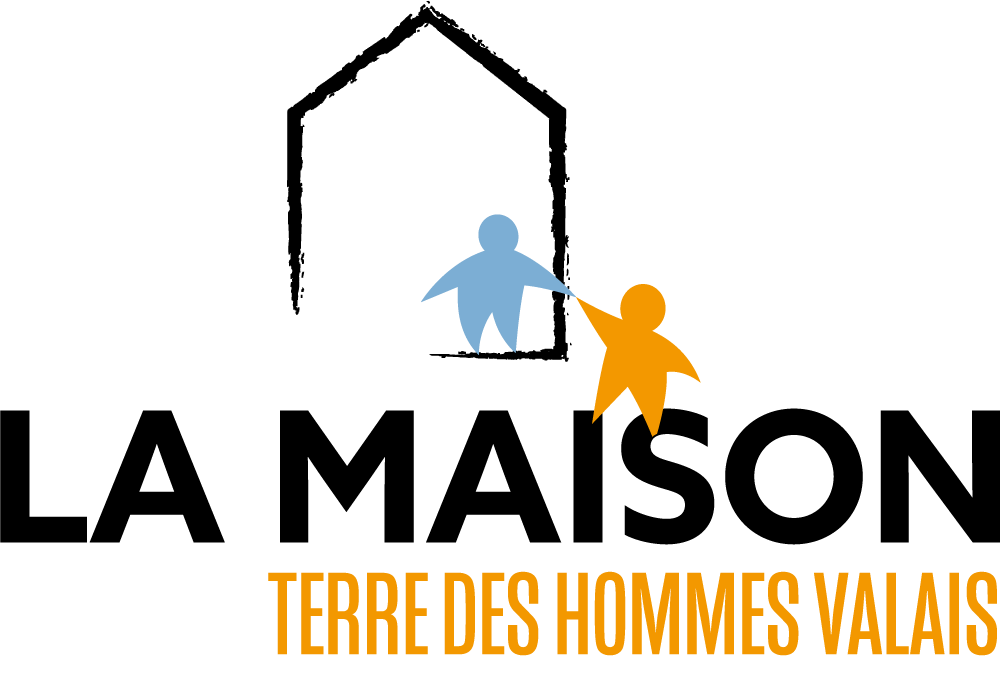Restoring dignity to a damaged childhood
written on the 26.03.2025The story of Mouctar, who was diagnosed with noma at the age of 3 and had surgery when he was 10
Mouctar’s story illustrates the complex journey of a child affected by noma. This devastating disease, nicknamed “flesh-eating”, disfigures children’s faces, painful and stigmatising physical after-effects. In the most serious cases, there is a constriction in the jaw and the children could not open their mouth. Mouctar was three years old when he had this disability. Transferred to Switzerland at the age of ten by our partner Sentinelles, Mouctar underwent reconstructive surgery at Geneva University Hospitals (HUG) and received pre- and post-operative care at La Maison.
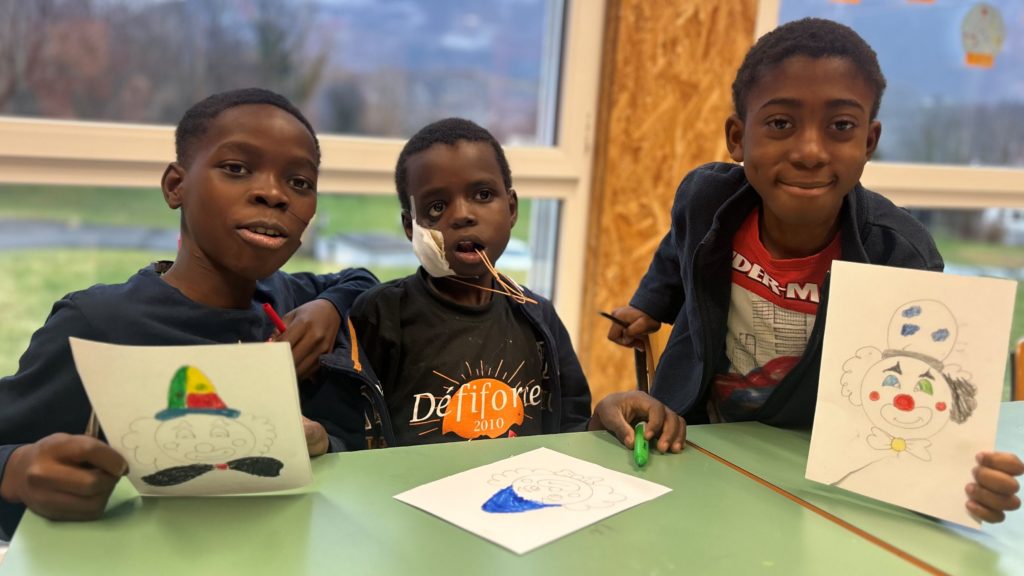
“The rigorous nursing and physiotherapy care provided at Massongex plays a vital role in achieving successful results after surgery.”
Dr Dominik André-Lévigne, surgeon at the HUG
A childhood marked by illness
Mouctar, the eldest of four boys, grew up in a remote region in Niger. In this village with no water or electricity, his family’s living conditions are precarious. In 2018, when he was just three years old, Mouctar started bleeding from his gums, developed a fever and swelling of the right cheek. A month after the first symptoms appeared, he was admitted to the reception centre run by our partner Sentinelles in Zinder, in the south of the country. There, he received first aid to combat noma. The treatment saved the child’s life, but the scars left on his face were irreversible.
Slowly Mouctar recovered and resumed a normal life, starting to go to school. For several years, the Sentinelles team has been monitoring his health. They waited patiently for him to reach the age and maturity required to undergo surgery and to follow the physiotherapy exercises essential to his rehabilitation.
Mouctar’s injuries were too serious to be done during a surgical mission. When Mouctar turned ten, our partner Sentinelles organised his transfer to Switzerland with the agreement of his parents.
Noma, a disease that ravages children’s faces
Primarily affecting young children, noma is a non-contagious disease that attacks the tissues and bones of the face. Its cause remains unexplained. However, malnutrition, poor oral hygiene and an immune system weakened by other illnesses are risk factors.
This bacterial infection develops in the mouth and progresses rapidly. If not treated in time, it leads to a frightening mortality rate, killing between 70% and 90% of affected children. Those who survive are left with terrible physical after-effects, such as a mutilated face and, in the most serious cases, a constricted jaw that prevents the mouth from opening. These complications lead to severe pain and difficulty in breathing, eating or speaking. There is also psychological suffering, as exclusion and stigmatisation weigh heavily on these children and their families.
A simple course of antibiotics administered early can stop the progression of the disease and treat the child in just a few weeks. However, access to medicines and treatment remains limited in many countries.
“We all share the same goal: the recovery of these children.”
Mélanie Casanova, nurse at La Maison
A warm welcome at La Maison
Mouctar arrived at La Maison at the end of September 2024, at the same time as two little Nigerian girls who had also suffered from the after-effects of noma. Mouctar takes them under his wing, acting like a big brother. This new environment is a real challenge for him. Here, water flows from the tap and toys are available, all things that, for so many children around the world, are a luxury.
Discreet and observant at the beginning, Mouctar gradually blossomed over the months thanks to the caring and attentive care of the educational team. He has a thirst for discovery, loves going to school at La Maison and making new friends.
“For some children, especially the younger ones, it can be impressive to see the after-effects of noma. We prepare them before the arrival of an affected child, so that integration goes as smoothly as possible”, explains Tania Kébé, co-head of the education sector. “Mouctar gets used very well to his new environment and has even learnt to speak French. He’s a lively, jovial boy!
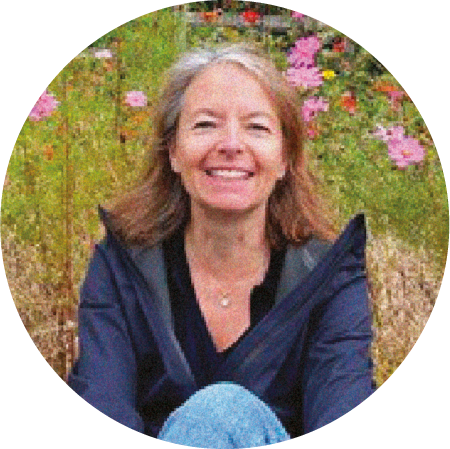
Our partner Sentinelles’ view
Interview with Joëlle Dentan, Head of the Sentinelles Care Programme
What is the role of La Maison de Terre des hommes Valais for Sentinelles in supporting children in care who have been affected by noma?
A place of trust, where we know that the child is cared for in a professional and caring way, both medically, in terms of follow-up care, and socially and educationally. A richly rewarding place where children are surrounded and respected, where they can be with their pairs and make progress in their learning. It’s a protective home that allows them to get through their stay in Switzerland and their treatment as calmly as possible.
What motivates the Sentinelles teams to continue this often difficult but vital work?
The children’s smiles, the fact that they can continue their lives in better health and even survive in case of heart disease. That the victims of noma are no longer stigmatised and that they can be included in their community. The families are very grateful for the care given to their child and it’s also a great motivation. Trying to move forward and again towards a fairer, more humane world to fight against inequalities gives meaning to our work.
What would you like to say to potential donors and partners to encourage them to join this wonderful chain of solidarity?
Your donations save lives, restore the faces of children disfigured by a terrible and unjust disease, and enable victims to regain their dignity and their childhood lives. It is thanks to our partners and this wonderful chain of solidarity that we are able to help girls and boys recover. Alone we can do nothing; together we can make it all possible.
A complex operation
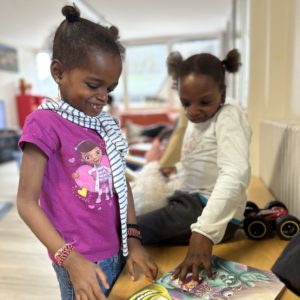
During the first few weeks at La Maison, Mouctar made regular visits to the HUG for preoperative examinations. Using imaging techniques, the medical team meticulously analyses the anatomy of his face to determine how it can be reshaped so that he can regain his functional abilities. They also identify the areas of the body where the skin and muscles to be transferred can be harvested. “In the case of the after-effects of noma, several operations may be necessary. We use different facial reconstruction techniques depending on the degree of damage to the skin, soft tissue and bone. These complex operations require surgical, nursing and physiotherapeutic expertise”, explains Dr Dominik André-Lévigne, who operated on Mouctar.
The preoperative consultations are also an opportunity to build up the child’s confidence, so that he can get used to the hospital environment and the nursing staff who will be looking after him. Mouctar was operated 29 November 2024 and returned to La Maison on 19 December. “The operation went very well overall. Because of a delay in vascularisation in part of the transferred flap, a second operation was necessary to check that this part of the flap was viable”, adds Dr André-Lévigne.

Our medical partner’s view
Interview with Dr Dominik André-Lévigne, head of clinic in the Department of Plastic, Reconstructive and Aesthetic Surgery at the HUG
How do you prepare for complex operations such as those required for children affected by noma?
All the children undergo radiological examinations, which allow us to assess the bone situation in their face, the anatomy of the vessels in their neck and the presence of soft tissue inside their mouth. These analyses enable us to obtain a 3D digital reconstruction of the child’s head. If complex bone reconstruction is required, we 3D print the bone structure so that we can work with the maxillofacial surgery department to plan the best possible procedure.
How does La Maison de Terre des hommes Valais play a crucial role in the convalescence and support of the children after operations?
Care for children suffering from the after-effects of noma is based on three fundamental pillars: children are welcomed at La Maison, care is provided free of charge by the HUG, and children are transferred and monitored over the long term by Sentinelles. This unique high-quality programme guarantees appropriate care. The rigorous nursing and physiotherapy care provided at La Maison in Massongex, and subsequently by Sentinelles in the children’s country of origin, plays an essential role in achieving successful results after surgery.
What has this work taught you about health inequalities around the world, and how do you see your role in this dynamic?
Over and above the fact that some parts of the world have better access to healthcare than others, the issue of inequality poses a real moral dilemma. The decision to operate on one child rather than another ultimately rests in the hands of a handful of people. I have mixed feelings about these situations, but I’m happy to help to improve the quality of life of the children I operate on.
In order to guarantee optimum care for a greater number of children, it would be necessary to train teams on site. Noma reconstructive surgery is a very difficult sub-specialisation to teach, as it involves surgeons with an excellent level of plastic surgery. As humanitarian reconstructive surgeons, we play a decisive role when we have the opportunity to train colleagues working in less developed countries.
Rigorous post-operative follow-up
At La Maison, post-operative monitoring is essential to ensure optimal recovery. “To avoid any complications, we regularly check the flap transferred to the face. We check its colouration and the absence discharge. We disinfect the wounds, apply an antibiotic cream and administer the medication prescribed by the surgeon. In addition, we monitor the scars where the flap was removed”, explains Mélanie Casanova, a nurse at La Maison. “We also pay close attention to mouth care, using a disinfectant solution for the first few weeks. After the operation, and before it, oral hygiene is essential. The children brush their teeth in the infirmary.”
Follow-up at the HUG is also an important part of the recovery process. Mouctar returns every week for check-ups. The medical team renews the dressing on the flap and Dr André-Lévigne carefully monitors the healing of the wound. He decides when physiotherapy can begin, and then authorises the child’s return home once he has regained sufficient mouth opening.
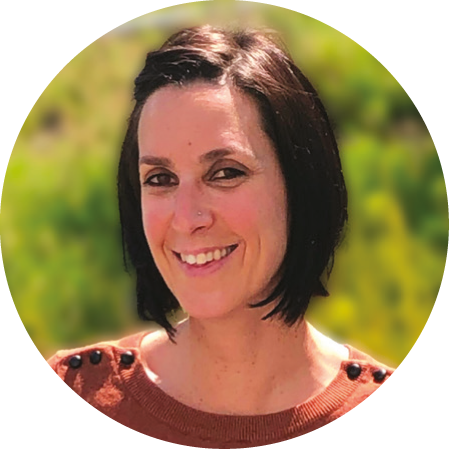
The La Maison care team’s view
Interview with Mélanie Casanova, nurse
How do you ensure that children operated on for the after-effects of noma receive full follow-up care?
Follow-up at La Maison covers all aspects of the children’s care, including physiotherapy, daily assessment of their progress and monitoring of potential complications. If we have any problems after the operation, we can contact the on-call team in the Plastic, Reconstructive and Aesthetic Surgery Department at the HUG, where we are always given a professional and sympathetic welcome. We also work closely with Sentinelles, who attend all the children’s medical consultations. This interdisciplinary work is based on effective coordination, particularly through follow-up reports. We all share the same goal: the recovery of these children.
How do you establish a bond of trust with these children, who have often been through traumatic experiences?
By adopting a caring attitude, speaking comforting words and adopting reassuring non-verbal behaviour, we show children that we are there for them. Children’s trust is earned over time. We take care with our values and our personalities, which creates a human richness and a precious complementarity in the team.
What are your hopes for the future of children like Mouctar who have undergone surgery for the after-effects of noma?
More than hope, I am convinced that Mouctar and the other children transferred by Sentinelles will receive appropriate care when they return to their country. Everything is being done to ensure that they can continue to receive essential care, such as physiotherapy, for the rest of their lives. On a broader scale I hope that one day all the necessary care can be provided in the children’s countries of origin, and that noma will eventually be eradicated once and for all.
Physiotherapy: essential and for life
An essential step
After any surgical treatment for the after-effects of noma, physiotherapy is essential to restore maximum mobility to the jaw. The first treatment consists of massaging the transferred flap to encourage drainage. Gradually, a variety of exercises adapted to each child’s situation are added. The aim is for the child to eventually be able to open and close his or her mouth correctly, and also regain the ability to speak and eat normally.
At La Maison, three part-time physiotherapists take it in turns to look after children needing rehabilitation after surgery, their pathology. “I try to make the physiotherapy exercises interesting for the children by inventing games and adding life and joy to them. Mouctar and I imitate a cat meowing or a lion roaring. The idea is to stimulate facial muscles through different mimics, in addition to physiotherapy work inside the mouth”, explains Anne Manet, physiotherapist at La Maison.
“The physiotherapists see the children three times a week. As well Mouctar has three physiotherapy sessions a day with the nursing staff at La Maison. We try to make it fun for him, for example by letting him watch a cartoon”, explains Mélanie Casanova.
A lifelong requirement
Like all children who have undergone surgery for the after-effects of noma, Mouctar will have to continue his physiotherapy exercises on a daily basis for the rest of his life in order to keep his mouth open properly. As soon as he returns to Niger, the local Sentinelles team will provide long-term follow-up. These visits to his family will enable us to monitor his state of health, ensure that he has access to oral hygiene products and, if necessary, provide support for his schooling.
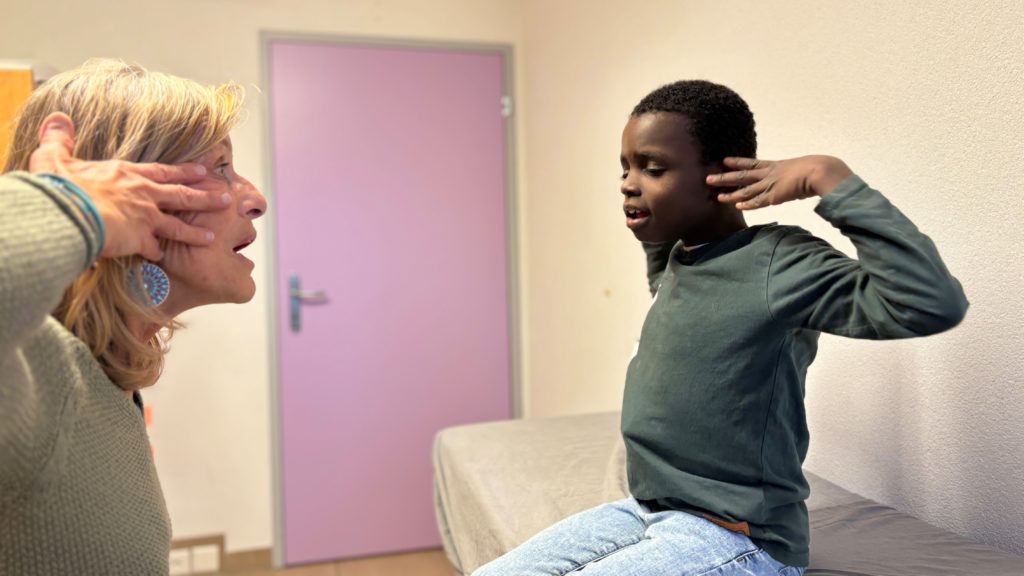
“I make sure that the physiotherapy exercises are interesting for the children by inventing games and adding life and joy to them.”
Anne Manet, physiotherapist at La Maison
Faced with this long course of treatment, young Mouctar’s courage is exemplary. Thanks to the invaluable support of our donors, many children like him can benefit from a safe and comforting environment during their convalescence at La Maison.
by Sanja Blazevic
